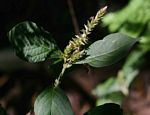Achyranthes aspera
sicula
Selected images: Click on each image to see a larger version and details of the record View all images (8)
Detailed records: Display species records QDS maps by: Google Maps Point records by Google Maps
Species details: Click on each item to see an explanation of that item (Note: opens a new window)
| Synonyms: | |
| Common names: | |
| Frequency: | |
| Status: | |
| Description: |
Slender erect perennial, sometimes climbing or scrambling. The leaves are often covered in silvery indumentum when young (less noticeable in shade growing specimens) Inflorescences dense at first but elongating up to 25 cm with more widely spaced flowers. Flowers greenish to silvey-white, often tinged with purple-red. |
| Type location: |
|
| Notes: | |
| Derivation of specific name: | aspera: rough |
| Habitat: | |
| Altitude range: (metres) | |
| Flowering time: | Nov - May |
| Worldwide distribution: | A naturalized weed of uncertain origin now widespread in the tropics and subtropics of the world |
| FZ divisions: | N,W,C,S |
| Zambian distribution (Provinces): | Cb,N,C,Lk |
| Growth form(s): | |
| Endemic status: | |
| Red data list status: | |
| Insects associated with this species: | |
| Spot characters: | Display spot characters for this species |
| Literature: |
Chapano, C. & Mamuto, M. (2003). Plants of the Chimanimani District National Herbarium and Botanic Garden, Zimbabwe Page 2. Chapano, C. & Mugarisanwa, N.H. (2003). Plants of the Matobo District National Herbarium and Botanic Garden, Zimbabwe Page 2. Heath, A. & Heath, R. (2009). Field Guide to the Plants of Northern Botswana including the Okavango Delta Kew Publishing Page 63. (Includes a picture). Kamumvuri, G. (ed.) (2004). Plants of Zimbabwe Report No. 1 National Herbarium and Botanic Garden, Zimbabwe Page 39. as Achyranthes aspera (Includes a picture). Mapaura, A. & Timberlake, J. (eds) (2004). A checklist of Zimbabwean vascular plants Southern African Botanical Diversity Network Report No. 33 Sabonet, Pretoria and Harare Page 15. Pickering, H. & Roe, E. (2009). Wild Flowers of the Victoria Falls Area Helen Pickering, London Page 20. (Includes a picture). Roodt, V. (2011). Wild flowers, Waterplants and Grasses of the Okavango Delta and Kalahari "Did You Know" nature series Struik Nature for Veronica Roodt Publications Page 9. (Includes a picture). Setshogo, M.P. (2005). Preliminary checklist of the plants of Botswana. Sabonet Report no. 37. Sabonet, Pretoria and Gaborone Page 20. Strugnell, A.M. (2006). A Checklist of the Spermatophytes of Mount Mulanje, Malawi Scripta Botanica Belgica 34 National Botanic Garden of Belgium Page 37. Townsend, C.C. (1988). Amaranthaceae Flora Zambesiaca 9(1) Pages 106 - 109. |
Other sources of information about Achyranthes aspera var. sicula:
Our websites:
Flora of Botswana: Achyranthes aspera var. siculaFlora of Malawi: Achyranthes aspera var. sicula
Flora of Mozambique: Achyranthes aspera var. sicula
Flora of Zimbabwe: Achyranthes aspera var. sicula
External websites:
African Plants: A Photo Guide (Senckenberg): Achyranthes asperaAfrican Plant Database: Achyranthes aspera
BHL (Biodiversity Heritage Library): Achyranthes aspera
EOL (Encyclopedia of Life): Achyranthes aspera
GBIF (Global Biodiversity Information Facility): Achyranthes aspera
Google: Web - Images - Scholar
iNaturalist: Achyranthes aspera
IPNI (International Plant Names Index): Achyranthes aspera
JSTOR Plant Science: Achyranthes aspera
Mansfeld World Database of Agricultural and Horticultural Crops: Achyranthes aspera
Plants of the World Online: Achyranthes aspera
Tropicos: Achyranthes aspera
Wikipedia: Achyranthes aspera
